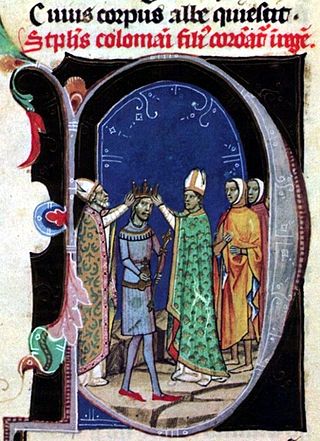Related Research Articles
Matthias from the kindred Rátót was a Hungarian prelate in the first half of the 13th century, who served as Bishop of Vác from 1238 to 1240, then Archbishop of Esztergom from 1239 until his death in the Battle of Mohi. He was the first Archbishop of Esztergom who was referred to as Primate of Hungary.
Fancica or Francica was a Hungarian prelate at the turn of the 11th and 12th centuries, who served as Bishop of Zagreb from around 1125 to 1131, then Archbishop of Kalocsa from 1131 until his death.
Desiderius or Ders was a Hungarian prelate in the 11th century, who served as Archbishop of Kalocsa from around 1064 to 1076.
Seraphin was a Hungarian prelate at the turn of the 11th and 12th centuries, who served as Archbishop of Esztergom from around 1095 until his death.
Nehemiah was a Hungarian prelate and politician, who served as Archbishop of Esztergom in the 1070s, during the reigns of Géza I and Ladislaus I of Hungary.
Macarius was a prelate in the Kingdom of Hungary in the first half of the 12th century. He was successively provost of Titel around 1127, bishop of Pécs between around 1136 and around 1139, and finally archbishop of Esztergom, until around 1147.
Kalán from the kindred Bár-Kalán was a prelate and royal official in the Kingdom of Hungary at the turn of the 12th and 13th centuries. He was bishop of Pécs from 1186 until his death in 1218, and ban of Croatia and Dalmatia between 1193 and 1194, thus he was the first prelate in the kingdom to parallelly held a secular office. Kalán's relationship with the monarch was tense in the reign of King Emeric who accused the bishop of incest but could never prove it. Although a part of the canons of Esztergom elected Kalán as archbishop in 1204, his election was not confirmed by the Holy See. Kalán died when planning to go on a crusade to the Holy Land.
Job from the kindred Záh was a Roman Catholic prelate in the Kingdom of Hungary in the 13th century. He was provost of the collegiate chapter of Székesfehérvár and vice-chancellor between 1251 and 1252, and bishop of Pécs from 1252 until his death in 1280 or 1281. He was involved in lasting conflict with the canons of his see, with the archbishops of Esztergom and with other prelates. Bishop Job was a partisan of the "junior king" Stephen V in the latter's conflict with the "senior king" Béla IV. Accordingly, Job reached the zenith of his influence in the period starting with the death of Béla IV, when he also held temporal offices in addition to his bishopric.
Marcellus was a Hungarian prelate at the turn of the 11th and 12th centuries, who served as Bishop of Vác from around 1111 to 1113, then Archbishop of Esztergom from around 1116 until his death.

Lawrence was a Hungarian prelate at the turn of the 11th and 12th centuries, who served as Archbishop of Esztergom from around 1105 until his death. He was a faithful confidant of Coloman, King of Hungary and the initiator of large-scale church organizational and canon law reforms in the Kingdom of Hungary.
Felician was a Hungarian prelate in the first half of the 12th century, who served as Archbishop of Esztergom from around 1125 until his presumably death in 1139 or later.
Ugrin from the kindred Csák was a Hungarian prelate at the turn of the 12th and 13th centuries, who served as Bishop of Győr from 1188 to 1204, then briefly Archbishop-elect of Esztergom in 1204.
Stephen (II) from the kindred Báncsa was a Hungarian prelate in the 13th century, who served as Archbishop of Kalocsa from 1266 until his death. He was a staunch supporter of Stephen V of Hungary.
Báncsa or Bancsa, also incorrectly Vancsa or Vancza, was the name of a gens in the Kingdom of Hungary.
Timothy was a prelate in the 13th century, who served as Bishop of Zagreb from 1263 until his death.
Peter was a Hungarian noble in the late 11th century, who served as Palatine of Hungary around 1091, during the reign of Ladislaus I of Hungary.
Julius was a Hungarian lord in the second half of the 11th century, who served as Palatine of Hungary at least from 1075 to 1090, during the reigns of Géza I then Ladislaus I.
James was a Hungarian Catholic prelate in the 13th century, who served as Bishop of Nyitra from 1223 until his death.
Gervasius was a Hungarian Catholic prelate in the 12th century. He was the first bishop of the Diocese of Nyitra in the Kingdom of Hungary, which was re-established after its Great Moravian roots two hundred years ago.
Grab, was a Hungarian nobleman in the late 11th century, who served as ispán of Somogy County around 1087–1090.
References
- ↑ Fejérpataky, László (1891). TURUL A Magyar Heraldikai és Genealogiai Társaság Közlönye (in Hungarian). p. 113.
- ↑ Koszta 2003, p. 29.
- ↑ Zsoldos 2011, p. 79.
- ↑ Koszta 2003, p. 30.
- ↑ Koszta 2003, p. 31.